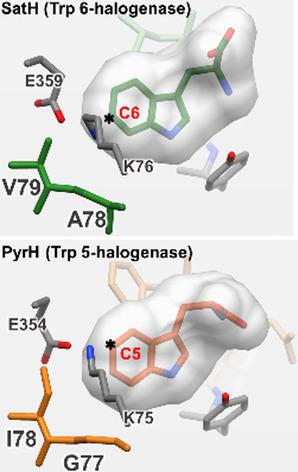当前位置:
X-MOL 学术
›
ChemBioChem
›
论文详情
Our official English website, www.x-mol.net, welcomes your feedback! (Note: you will need to create a separate account there.)
Characterization of a Tryptophan 6-Halogenase from Streptomyces albus and Its Regioselectivity Determinants.
ChemBioChem ( IF 3.2 ) Pub Date : 2020-02-27 , DOI: 10.1002/cbic.201900723 Jeongchan Lee 1, 2 , Joonwon Kim 2, 3 , Hyun Kim 1, 2 , Eun-Jung Kim 2 , Hee-Jin Jeong 4 , Kwon-Young Choi 5 , Byung-Gee Kim 1, 2, 3, 6, 7
ChemBioChem ( IF 3.2 ) Pub Date : 2020-02-27 , DOI: 10.1002/cbic.201900723 Jeongchan Lee 1, 2 , Joonwon Kim 2, 3 , Hyun Kim 1, 2 , Eun-Jung Kim 2 , Hee-Jin Jeong 4 , Kwon-Young Choi 5 , Byung-Gee Kim 1, 2, 3, 6, 7
Affiliation

|
Tryptophan halogenases are found in diverse organisms and catalyze regiospecific halogenation. They play an important role in the biosynthesis of halogenated indole alkaloids, which are biologically active and of therapeutic importance. Here, a tryptophan 6-halogenase (SatH) from Streptomyces albus was characterized by using a whole-cell reaction system in Escherichia coli. SatH showed substrate specificity for chloride and bromide ions, leading to regiospecific halogenation at the C6-position of l-tryptophan. In addition, SatH exhibited higher performance in bromination than that of previously reported tryptophan halogenases in the whole-cell reaction system. Through structure-based protein mutagenesis, it has been revealed that two consecutive residues, A78/V79 in SatH and G77/I78 in PyrH, are key determinants in the regioselectivity difference between tryptophan 6- and 5-halogenases. Substituting the AV with GI residues switched the regioselectivity of SatH by moving the orientation of tryptophan. These data contribute to an understanding of the key residues that determine the regioselectivity of tryptophan halogenases.
中文翻译:

来自白色链霉菌的色氨酸6-卤化酶的特征及其区域选择性决定因素。
色氨酸卤化酶存在于多种生物中,并催化区域特异性卤化。它们在卤化吲哚生物碱的生物合成中起着重要作用,这些生物活性具有治疗活性。在此,通过使用大肠杆菌中的全细胞反应系统来表征来自白色链霉菌的色氨酸6-卤素酶(SatH)。SatH对氯离子和溴离子显示底物特异性,导致在L-色氨酸的C6位发生区域特异性卤化。此外,在全细胞反应系统中,SatH在溴化方面的表现比以前报道的色氨酸卤化酶更高。通过基于结构的蛋白质诱变,已发现两个连续的残基,即SatH中的A78 / V79和PyrH中的G77 / I78,是色氨酸6-和5-卤化酶之间区域选择性差异的关键决定因素。用GI残基取代AV可以通过移动色氨酸的方向来切换SatH的区域选择性。这些数据有助于理解决定色氨酸卤化酶区域选择性的关键残基。
更新日期:2020-01-08
中文翻译:

来自白色链霉菌的色氨酸6-卤化酶的特征及其区域选择性决定因素。
色氨酸卤化酶存在于多种生物中,并催化区域特异性卤化。它们在卤化吲哚生物碱的生物合成中起着重要作用,这些生物活性具有治疗活性。在此,通过使用大肠杆菌中的全细胞反应系统来表征来自白色链霉菌的色氨酸6-卤素酶(SatH)。SatH对氯离子和溴离子显示底物特异性,导致在L-色氨酸的C6位发生区域特异性卤化。此外,在全细胞反应系统中,SatH在溴化方面的表现比以前报道的色氨酸卤化酶更高。通过基于结构的蛋白质诱变,已发现两个连续的残基,即SatH中的A78 / V79和PyrH中的G77 / I78,是色氨酸6-和5-卤化酶之间区域选择性差异的关键决定因素。用GI残基取代AV可以通过移动色氨酸的方向来切换SatH的区域选择性。这些数据有助于理解决定色氨酸卤化酶区域选择性的关键残基。


























 京公网安备 11010802027423号
京公网安备 11010802027423号